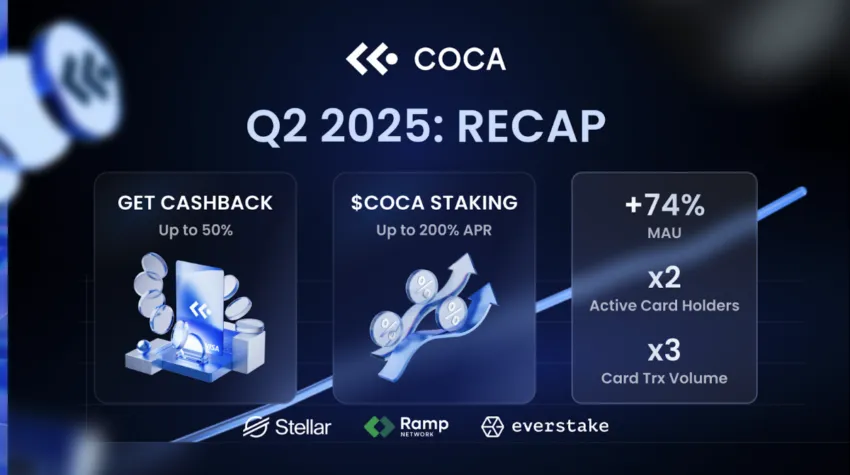While most consumer-facing projects are still wrestling with retention, non-custodial wallet COCA posted its strongest quarter yet. The company reported a 74% jump in monthly active users and a 101% increase in cardholders, with card transaction volume nearly tripling.
BeInCrypto sat down with Vasili Paulau, CEO of COCA, to unpack the company’s strongest quarter to date, explore the thinking behind its infrastructure and rewards strategy, and understand what the upcoming COCA 2.0 rollout means for the future of crypto usability.
Why COCA Is Gaining Traction in Q2
COCA’s stated mission is to help users move beyond storing crypto and start using it. According to its recent official report, in Q2, it delivered updates across staking, card rewards, infrastructure, and experience.
Card spend was COCA’s most-used feature in Q2, followed by cross-chain swaps and crypto purchases. Rather than frame crypto as something to stash away, the platform has positioned itself around practical utility.
Users can top up with stablecoins, spend directly from the wallet, or convert assets on the fly, all without switching interfaces. It is a model that blends fintech convenience with self-custody.
“Most stablecoins today are just sitting on exchanges. People buy them, maybe swap a little, but that’s where it stops. What we kept hearing from our users was, ‘I want to actually spend crypto, like money.’ No one wants to deal with extra steps or lose control over their assets. That shaped how we built COCA in Q2. Everything, from card spend to staking, is designed to feel seamless. It’s not about making crypto flashy. It’s about making it usable,” Paulau told BeInCrypto.
Built-In Staking, Simplified
Q2 also marked COCA’s entry into staking. The platform rolled out ETH staking through a partnership with Everstake, offering yields up to 4 percent APY. The process is handled entirely in-app, with no external interfaces or technical flows.
Users also gained the ability to stake the $COCA token itself, with yields advertised as high as 200 percent APR. A full UI upgrade for the feature is expected in the coming quarter. To reduce onboarding friction, the team introduced a built-in staking guide.
“For most people, staking still feels too complicated. It’s usually buried in external interfaces, full of jargon, and easy to get wrong. We wanted to change that. With COCA, staking ETH is designed to feel as familiar as setting up a savings account in your banking app. Just clear steps, all in one place,” Paulau explained.
COCA also expanded its rewards model, introducing cashback mechanics that feel closer to neobank behavior than to traditional Web3 tokenomics. Users earn 5 percent back on everyday purchases and 50 percent back on subscriptions including Netflix, Spotify, Amazon Prime, ChatGPT, and Apple Music.
A travel feature is also in development, with up to 50 percent off hotel bookings. All rewards are paid monthly in USDT, with earnings tracked inside a dedicated cashback summary screen. Paulau shared that since launching cashback in Q2, COCA has seen a shift in how users approach everyday spending.
“Once users saw they could get stablecoins back on things they were already paying for, they started reaching for the COCA card more often. It’s simple, but it works. That one change made people stick around longer,” he said.
Infrastructure Changes That Actually Matter
Most crypto wallets are built to help users store and manage digital assets. But few have focused deeply on what happens after onboarding—particularly when it comes to everyday usability.
In Q2, COCA introduced a set of quiet but important infrastructure upgrades aimed at reducing friction in the user journey. Some of these updates may appear minor on the surface: in-app confirmations for online payments, clearer tracking for card delivery, and transaction history in local currency. But taken together, they reflect a product approach that prioritizes user experience over protocol mechanics.
Wallet activation on Stellar no longer requires a deposit. Push and Telegram alerts show real-time activity. KYC now runs automatically in the background, reducing interruption. Even routine flows like card ordering have been streamlined.
None of these changes are headline-grabbing on their own. But they address exactly the kinds of pain points that often lead to user drop-off, especially for those less familiar with crypto workflows.
“Most of the updates in Q2 came from watching where people got stuck. Some users needed help just to activate their wallets. Others were messaging us about card deliveries or payments that didn’t go through. We didn’t need to build anything fancy. We just had to clear the friction that was getting in their way,” said Paulau.
Campaigns That Reward Participation
COCA’s growth strategy also leaned into user-driven campaigns. A March airdrop, concluded in April, distributed $5 to $2,900 worth of COCA to eligible users. The platform followed with a staking giveaway offering 0.1 ETH to 10 winners and a five-week “Lucky Drops” campaign that delivered random assets like ETH, SOL, DOGE, and XLM to active wallets.
A revamped referral program also launched, offering $10 each to referrer and referee after a qualifying card transaction.
The campaigns were framed not as speculation events, but as thank-you mechanisms. That framing, while subtle, signals a shift in tone and intent.
Building Access Before the Spotlight Hits
Q2 also brought broader ecosystem moves. In the US, COCA added support for crypto purchases via Visa, Mastercard, and Apple Pay through an integration with Ramp. Early users received 3 percent cashback in $COCA.
Exchange access also widened. The token, already listed on MEXC and BitMart, was added to Uniswap and Exolix. At Stellar Demo Day, COCA showcased its MPC-based wallet infrastructure and emphasized security-first design.
“We chose MPC because we didn’t want users thinking about seed phrases or recovery keys. Most people just want to feel safe without having to understand what’s happening under the hood. MPC lets us offer that balance. It keeps things non-custodial, but also makes onboarding less intimidating,” Palau elaborated.
COCA 2.0: A Redesign, or a Rethink?
COCA has confirmed that a full redesign and platform evolution, internally referred to as “COCA 2.0,” is planned for Q3 and continuing into the following months. According to internal documentation, upcoming features include COCA Travel, which will offer up to 50 percent discounts on hotels; an “Earn on Balance” feature that generates passive yield on idle stablecoin balances; and a new affiliate program aimed at scaling reach.
Further updates will introduce major chain integrations and performance upgrades, though the team has not yet disclosed full details.
At the end of our conversation, Paulau shared that the goal of COCA 2.0 goes beyond adding features. The team is aiming to change how users experience crypto in their day-to-day life.
“This next phase is about giving people a full financial experience powered by stablecoins. You can spend, earn, and grow your crypto in one place without needing to move between apps or deal with traditional banks. The interface is cleaner. The real change is how much simpler everything feels,” he concluded.
Disclaimer
In compliance with the Trust Project guidelines, this guest expert article presents the author’s perspective and may not necessarily reflect the views of BeInCrypto. BeInCrypto remains committed to transparent reporting and upholding the highest standards of journalism. Readers are advised to verify information independently and consult with a professional before making decisions based on this content. Please note that our Terms and Conditions, Privacy Policy, and Disclaimers have been updated.



